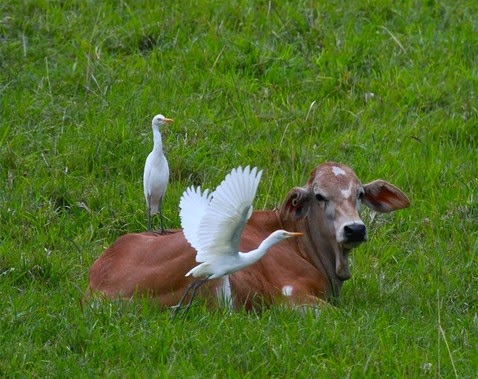Examples of commensalism
What is commensalism?
The cattle egret is a general
species of heron. They are found in almost every region of the world. They are
mostly seen moving along with the shepherd of cattle. The bird moves around and
follows the cattle. The cattle egret eats the insects those are hiding
themselves under vegetation near to the ground and get moved up when the cattle
walks through them. Here the cattle get the benefit by eating the insects and
the livestock remains unaffected totally.
Orchids, a flowering plant
grows on the branches of trunks or other trees. Orchids are generally found in
tropical forests. They form their bases on the branch of trees and gains
benefit by getting sunlight and nutrition that flows down the branches. The
orchids do not grow large and hence the host tree is not harmed any way.
Some species of
pseudo-scorpions hide themselves under the wing covers of large insects like beetles
protect them from the predators and provide a way of transportation.
Pseudo-scorpions are scorpion like insects, very small in size almost one
centimeter in length or even less than that. As it has no sting, does not harm
the beetle in any way.
A common wild plant called
burdock is found along a roadside or generally in an empty field. You can see
the seed heads in the picture have long spines with hooked tips. The hooked
tips, catches the hair of cows, dogs, deer or human passing by and are carried
elsewhere until they are pulled off by the carriers.
Commensalism
is the word derived from the English word commensal which means eating at
the same table or sharing food generally using of one's waste food as another food or
sharing food without any harm to other .
Commensalism
is a type of relationship between two plants, animals, mammals or fungus, etc.
where one lives with another without damaging the other.
Commensalism
may be defined as the practice or situation in nature where two species live
close together in association where only one partner gets the benefit and the
other is neither helped nor harmed and remain as usual. One of the species gain
from increased food supply mainly but the other gets nothing from the relationship.
For
example:
·
Silverfish and
Army Ants: Silverfish cleans the nest of army ants without harming them.
·
Human and
Roaches: Roaches eat the garbage, humans leave behind.
·
Remoras and
Sharks: Remoras eat the scraps which are scattered by the sharks feeding.
A
bird that is living in a tree can be an example of commensalism.. Here the bird live in the tree to get
shelter, where the tree does nothing and is neither helped nor harmed by the
bird.
The
species that benefits from the relationship can obtain shelter, support or
locomotion from the host species which greatly remain unchanged. The relation
is often between larger host and a smaller commensal.
Some
organisms connect themselves to some other organisms for transportation or to
achieve better access to food. Others use the host as a shelter. Such as:
Squirrel and trees acts vice versa. A tree usually grows the fruits and nuts
and squirrel just eats them.
Examples of Commensalism
Cattle,
horses and other livestock, usually graze in the field. They cause movement in
which various insects stir up. Cattle egrets following the livestock catch and
feed upon them. The egrets benefit from this relationship as because the
livestock helped them find their meals. The livestock remains unaffected.
Labels: commensalism, commensalism example, commensalism in animals.commensalism in plants, what is commensalism





